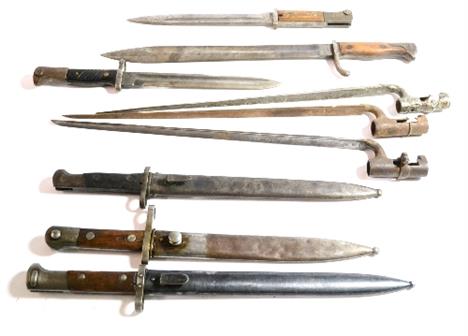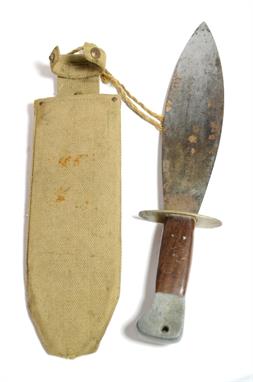We found 98580 price guide item(s) matching your search
There are 98580 lots that match your search criteria. Subscribe now to get instant access to the full price guide service.
Click here to subscribe- List
- Grid
-
98580 item(s)/page
A George VI period naval officers sword, the 79cm single edged single fullered blade, with acid etched decoration of a fouled anchor and George VI cipher surmounted by a crown, maker Gieves, with fish skin grip with twist wire decoration, the guard decorated with a fouled anchor, lions head pommel and fold down guard engraved D.C White R.N., together with sword knot complete with a matching brass and leather mounted scabbard, chamois leather sword bag with brown leather outer sword bag (see lot 381 for his medals) (illustrated)
An early 20th century naval officers sword, the 73cm curved single edged and single fullered blade with acid etched decoration, brass grip decorated with a fouled anchor surmounted by a crown, fish skin grips with twist wire decoration, complete with a leather and brass mounted scabbard, the brass mount stamped J. Mackay Devonport
A 1796 pattern light Cavalry sabre probably for a child or youth, the short 60cm curved single edged blade decorated with martial scenes with traces of bluing and gilding, with makers mark Hunter & Co warranted, with fish skin covered grip with twist wire decoration, with brass guard and fittings complete with a matching brass scabbard. Swords like these were produced for the sons of nobility who were in the militia at that time (illustrated) CONDITION REPORT: Rust damage to blade and edges no notching to blade (see image)
An Imperial German S98/05 bayonet, the 36cm single edged single fullered blade stamped Fichtel and Sachs Schweinfurt, wooden grips complete with metal scabbard, a French chassepot bayonet, the 56cm Yataghan blade with solid brass grips, steel quillon, complete with metal scabbard, a French gras bayonet, the 52cm single edged blade dated 1878 with wooden grips, brass pommel, complete with metal scabbard and leather frog, also with this lot a collection of medals comprising a pair awarded to L-10097 Driver F. Wilcocks of Royal Field Artillery comprising 1914-15 Star and War for Civilisation Medal, further War for Civilisation Medal awarded to 78890 Private R A Harker of the Liverpool Regiment, 1939-45 Medal and a group of mid WWII medal miniatures, also with this lot a polished copper medal commemorating the royal visit of George V and Queen Mary and a collection of tokens etc CONDITION REPORT: Scabbards have rust marks Chassepot scabbard missing loop holder and dents, different numbers on Chassepot Blade point rounded off No numbers on S98, Gras number on crossguard but none visible on scabbard
A German Third Reich Army Officer`s Dagger, the steel blade etched with maker`s mark Siegfried, Ernst Pack & Sohne MBH Waffenfabrik, Solingen, Waffen, the white metal hilt bearing traces of silver plating, with wrythen fluted orange plastic grip, silver metal thread portapee and with pebbled white metal scabbard
A German Third Reich Parade Bayonet, the blade with maker`s squirrel logo for Original, Eickhorn, Solingen, with chequered black plastic two piece grip scales and black painted steel scabbard with leather frog; a Mussolini Folding Penknife, the reeded steel casing embossed with the head of a soldier; a Copy of a Hitler Youth Knife, made from a scout knife, with leather waist belt (4)
A German Third Reich Army Sword, the 83cm single edge fullered steel blade with maker`s mark for E Pack & Sohne, Solingen, the brass dove head hilt worked with acorns and oak leaves, with eagle and swastika to one langet, wire bound black plastic grip, black painted steel scabbard and silver metal thread portapee with silver and leather strap
A German Third Reich RAD Enlisted Man`s Hewer, the clip point steel blade with a narrow fuller to each side, one side etched Arbeit adelt, the other with maker`s logo for Carl Eickhorn, Solingen below RJAD within a triangle and GES.GESCHE., the silver plated hilt with two piece antler grip scales, the black enamelled steel scabbard with plated mounts engraved with Celtic style knotwork and RAD badge
A German Third Reich SS Dagger with Chains, the double edge steel blade etched Meine Ehre heist Treue, the nickel hilt with ebony grip inset with enamel SS runes and eagle and swastika, the black enamelled steel scabbard with three metal mounts, the centre mount with raised key pattern on a pebbled ground, and set with a four panel link chain worked with skulls and SS runes, the upper chain of two panels, lacks hanger piece
A German Third Reich SA Dagger, the double edge steel blade etched Alles fur Deutschland and with maker`s logo for Hermann Hahn Sol.-Wald, the nickel hilt with Om mark to the crossguard, the wood grip inset with enamel SA badge and eagle and swastika, with nickel mounted brown enamelled steel scabbard
A First World War Period Naval Officer`s Sword, the 73cm single edge steel blade etched with a fouled anchor and foliage, by Matthews & Co., Portsea, the gilt brass gothic hilt cast with a fouled anchor, with wire bound fishskin grip and lion head pommel, the hinged guard engraved H A Bickford R.N., with brass mounted leather scabbard and bullion thread sword knot; a Naval Officer`s Black Silk Bicorn Hat, with black lace trim, rosette and bullion coils, in a black japanned tin case, to Acting Lieutenant Arthur Henry Andrews R.N., together with a portrait photograph and copy of his Service Record (4) **All the items belonged to Act.Lieutenant Andrews - the sword was one he took home from a party by mistake, leaving his own behind
A British Second Pattern Commando Knife, with 16.5cm hand forged double edge steel blade, plain oval crossguard and knurled brass grip, with part of the original leather scabbard in an orange webbing cover; a Fourth Pattern Commando Knife, with machine forged blued steel blade, ribbed alloy grip, the pommel moulded 4, with brass mounted leather scabbard (2)
A Bowie Knife, the 17.5cm clip point steel blade stamped WILLIAM RODGERS I CUT MY WAY, the handle of stacked leather washers with aluminium pommel and leather scabbard; a Nepalese Kukri, with fullered steel blade, horn grip and leather scabbard; two Indian Kukris, each with horn grip and leather scabbard (4)
A 19th Century Prussian Infantry Sword, the 83cm single edge double fullered steel blade stamped with the maker`s logo for Alcoso, the gilt brass hilt with triple bar guard cast with the Prussian eagle, the silver wire bound fishskin grip set with crowned W III R cypher, with plated steel two ring scabbard
A Victorian 1854 Pattern Sword to an Officer of the Foot Guards, the 82.5cm single edge fullered steel blade crisply etched with the Royal cypher and Regimental badge with battle honours on a ground of foliate strapwork, with a family crest of a squirrel over the officer`s initials F.A.D.V., by Henry Wilkinson, Pall Mall, London, the back edge stamped 15103, the steel gothic hilt pierced and cast with the Regimental badge, with wire bound fishskin grip and steel scabbard
An Edwardian Court Sword, the 77.5cm triangular section steel blade etched with scrolling foliage and crossed standards by Poole & Co., Savile Row, London, the cut steel hilt with pierced shell guard, stirrup knuckle bow and urn pommel, lacks scabbard; a French Fencing Sabre by Leon Paul, with aluminium bowl hilt and chequered wood grip; a German 1898-05 Butcher Bayonet, second pattern, with steel scabbard (3)
A First World War British 1908 Pattern Cavalry Trooper`s Sword, 88.5cm single edge fullered steel blade stamped at the ricasso with SS&M, broad arrow, and inspector`s stamps, the back edge stamped P`08, with original buff-piece, reinforced steel bowl hilt, chequered dermatine grip with thumb depression, with steel scabbard stamped MOLE 12
A Victorian Court Sword, the 78cm double edge steel blade etched with martial trophies and foliage, the brass stirrup hilt with shell guard, wire bound fishskin grip and baluster pommel, lacks scabbard; a Large Bronze Medal - Dr Edward Salk, Benefactor of Mankind, by the Medallic Art Co., New York (2)
A 17th Century Mortuary Sword, circa 1640, the 83.5cm single edge steel blade with two fullers to each side signed ANDRIA FERARA, the steel half basket hilt pierced and worked with masks and foliage, the scroll guard bars attached to the globular pommel with three screws, with wire bound fishskin grip, lacks scabbard
A 17th Century German Hunting Hanger, the 57cm single edge steel blade with a narrow fuller running along the back edge, double edged at the tip, engraved with running stag and boar and interlaced strapwork, the brass hilt with shell guard, short bar crossguard, shaped knucklebow set with a canted rectangular plate, the fruitwood grip set with brass strapwork and pique decoration, with fluted nipple pommel, lacks scabbard
An Imperial German Army Sword, the 80cm single edge fullered steel blade etched with martial trophies and foliage, the brass stirrup hilt with rounded langets, one cast and chased with a vacant shield, the other with a stand of arms, the similarly decorated knucklebow headed by an Imperial cross, with shaped wire bound fishskin grip and lion head pommel, with black painted steel scabbard
A German 1898/05 Butcher Bayonet, second type, the blade stamped WAFFENFABRIK MAUSER A/G/ OBERNDORF a.N., lacks scabbard; a Czechoslovakian VZ24 Mauser Knife Bayonet, with steel scabbard; a Turkish Model 1935 Mauser Bayonet, the pommel stamped A.S.F.A., with steel scabbard; three Various Socket Bayonets, and three knife bayonets (9)
-
98580 item(s)/page




























































